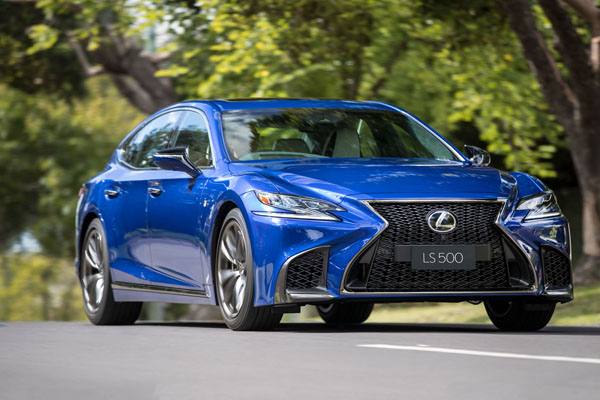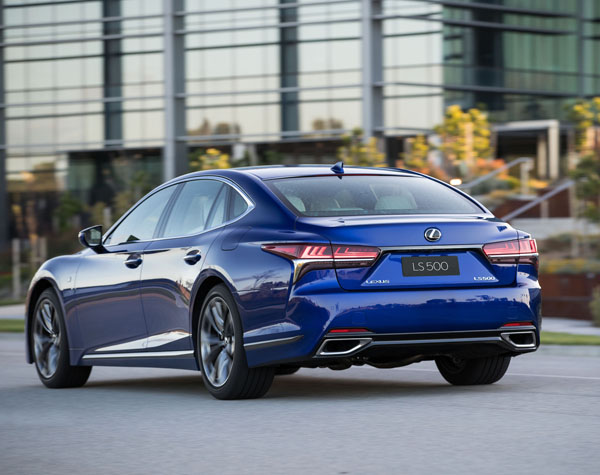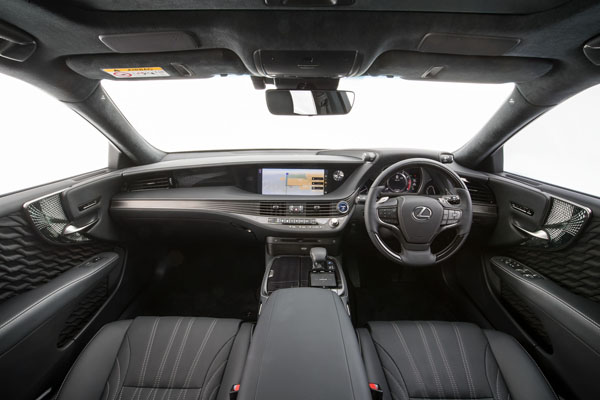
Lexus would be the first to admit its first large sedan, the LS 400, which landed in Australia in 1989, took many of its cues from Mercedes-Benz luxury saloons. Thirty years later, the LS 500 takes its place as a pure Lexus – a dynamic hand in a velvet glove.
The fifth generation of the Lexus flagship, the LS 500 is based on the new Lexus LC 500 Coupe’s rear-drive platform and has a coupe-style silhouette with the company’s first six-window sedan profile.
Lexus engineers tell us they looked to F1 technology to produce a high-performance engine with exceptional fuel efficiency. The LS 500 3.5-litre V6 twin turbo pumps out 310 kW and 600 Nm as opposed to 285 kW and 493 Nm of the 4.6-litre naturally aspirated V8 it replaces.
The regal range opens with the LS 500 F Sport, costing $205,343 on the road, and ‘processes’ up to the Sport Luxury at $211,040. A couple of enhancement packs each add $10,000 to the total price. On test was the LS 500 Sport Luxury.
STYLING
The LS 500 takes the Lexus flagship into a new realm of luxury vehicles – from stolid saloon to swoopy coupe.
Up front, the focus is on the latest iteration of the company’s signature spindle grille, this time with a texture that appears to change depending on the light. It’s the result of hand-shaping thousands of individual surfaces.
On either side, narrow three-projector lamps merge with an L-shaped LED lights that wrap broadly around to the side. The shoulder line continues to the rear, giving the vehicle a low stance, while the front and rear guards are slanted forward for a dynamic effect.
As for aerodynamics, a sleek silhouette with fastback roof, flat underside, flush side window glass and air-stabilising fins, among other things, ensures the LS 500 is up to a 0.29 Cd co-efficient of friction.
The 20-inch Sports Luxury wheel features a hollow-rim structure that helps reduce resonant sounds generated by the tyres.
INTERIOR
Fine leather in a choice of four colour schemes, upmarket stitch work and detailed metal and wood accents greet passengers as they step into the LS 500 cabin.
There’s more interior room thanks to the new LS platform, with its longer wheelbase. Cabin length has been increased to 2145 mm and distance between occupants to 1080 mm. Rear leg room in the Sports Luxury models has been increased by 86.3 mm to 989 mm.
Information is displayed to the driver at a uniform height so they don’t have to move their eye level. To the left of the driver is the next-generation Lexus Remote Touch Interface, designed to mimic smartphone operation and with the choice of handwritten input.
A 12.3-inch wide navigation display and 8-inch TFT multi-information screen are complemented by a 600 mm colour head-up display projecting information onto the windscreen ahead of the driver.
The new three-spoke steering wheel is 10 mm smaller in diameter than the superseded LS and in the Sports Luxury model is heated and has wood inserts.
Takumi master craftspeople are responsible for Kiriko cut-glass ornamentation and hand-folded pleats, based on origami paper folding, on the door trim.
INFOTAINMENT
The new LS 500 has the finest-quality 23-speaker 3D Mark Levinson QLI Reference Surround Sound audio system, which is unique to Lexus’ most exclusive models, and the company says it is destined to be the benchmark for the next decade.
Sports Luxury models feature a rear-seat entertainment system with 11.6-inch LCD screens in the front seatbacks and Blu-ray Disc player at the rear of the centre console. The rear centre armrest has a multi-operation panel, HDMI port and headphone sockets.
In addition to its premium sound system, Lexus LS 500 and LS 500h have active noise control, to detect when engine noise enters the cabin and cancel out certain frequencies using anti-phase sound from the audio speakers.
ENGINES / TRANSMISSIONS
The LS 500 is powered by a 3.5-litre twin turbocharged petrol V6 engine producing 310 kW of power at 6000 rpm and 600 Nm of torque between 1600 and 4800 revs. It’s mated with the ten-speed automatic, which recently debuted in the Lexus LC 500, the first time one had been seen in a premium passenger car.
The driver can dial up powertrain response, choosing from Eco, Normal, Sport S or Sport S+.
SAFETY
The LS 500 is equipped with the Lexus Safety System+, which includes pre-collision system, adaptive cruise control, lane-keep assist, lane departure warning and sway warning, adaptive high beam and lane trace assist, which helps following in traffic.
Speed limit sign recognition comes up on the dashboard and head-up windscreen display and there’s the option of an audible overspeed warning no thank you for the latter.
DRIVING
Welcome to luxury, Lexus style. The access mode automatically raises the low-slung LS 500 by 40 mm to an ideal 555 mm hip height in just four seconds when the vehicle is unlocked. Once the occupants are on board and the engine switched on, the car returns to its regular ride height. The sequence is reversed when it is time to get out of the vehicle.
The LS 500 makes good use of high performance V6 combined with fuel economy as opposed to the out-and-out grunt of the previous V8. As far as the latter is concerned, I’ll take Lexus’s word for it that the car will sprint from rest to 100 km/h in five seconds but experienced the test vehicle’s relatively miserly fuel use of 10 litres per 100 km on a mix of town and country driving, the engine offering up sound perfectly matched to the level of performance.
I must admit I was never a fan of the centre console touchpad control: too touchy, especially for a non-left hander. The LS 500 version has changed nothing about my reservations. I much preferred the joystick with its positive resistance to movement making it far more controllable.
Lexus has included Shiatsu massage in the front and rear seats, as well as a world-first rear-seat spot-heating function, which can be tuned to act on varying parts of the body. Five separate front-seat massages can help relax the driver without impairing control of the car. And did I mention the nice feel of the steering wheel?
For those wishing to immerse themselves in the total luxury lifestyle, the ottoman seat in Sports Luxury has three pre-set positions: business, the default; entertain, which reclines the seat for the ultimate viewing of the entertainment monitor, and relax, which extends the leg ottoman, reclines the seatback and moves the front passenger seat to its furthest forward position.
In addition to its premium sound system, Lexus LS 500 has active noise control to detect engine noise entering the cabin and cancel out certain frequencies using ‘anti-sound’ from the speakers.
SUMMING UP
It’s tempting to say Lexus has thought of everything to produce one of the best prestige cars on the road. And for the CEO in a time-poor business situation he or she can rely on being pleasantly transported by the LS 500 in the comfort of a limo.
AT A GLANCE
MODEL LINE-UP (All prices on road)
LS 500 F Sport $205,343
LS 500 Sport Luxury $211,040
LS 500 Sport Luxury + Enhancement Kiriko Glass ornamentation with pleated door trims $221,465
LS Sport Luxury + Enhancement Chestnut L-Aniline leather $221,465
SPECIFICATIONS (Lexus LS 500 3.5-litre V6 twin-turbo petrol, 10sp automatic sedan)
ENGINE:
Capacity: 3.444 litres
Configuration: Six cylinders in ‘V’ format
Maximum Power: 310 kW @ 6000 rpm
Maximum Torque: 600 Nm @ 1600-4800 rpm
Fuel Type: Petrol 95 RON or higher
Combined Fuel Cycle (ADR 81/02): 9.5 L/100km
CO2 Emissions: 217 g/km
DRIVELINE: Ten-speed automatic transmission
DIMENSIONS, WEIGHT AND CAPACITIES:
Length: 5235 mm
Wheelbase: 3125 mm
Width: 1900 mm (mirrors folded)
Height: 1450 mm
Turning Circle: 11.4 metres
Gross Vehicle Mass: 2670 kg
Fuel Tank Capacity: 82 litres
BRAKES:
Front: Ventilated disc
Rear: Ventilated disc
STANDARD WARRANTY:
Three years / unlimited kilometres, plus 10-year complimentary roadside assist













